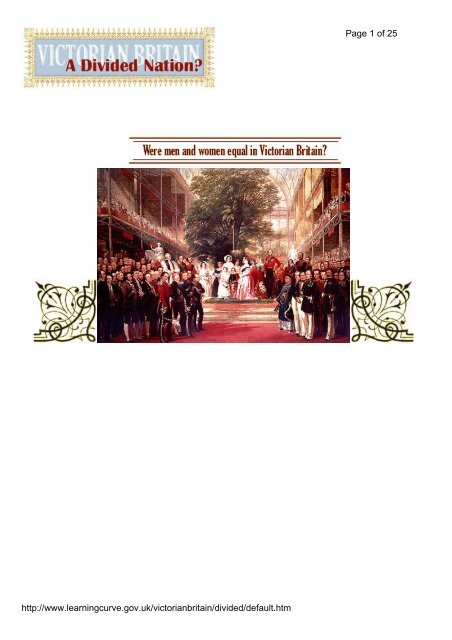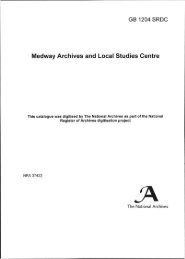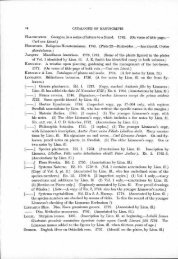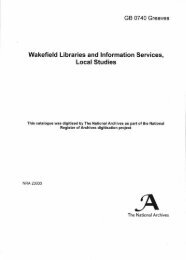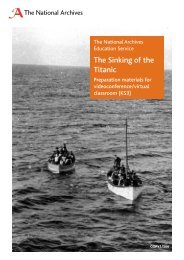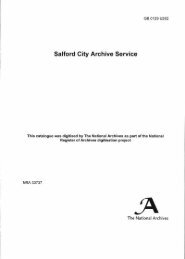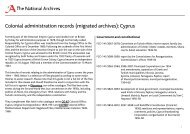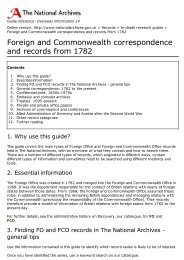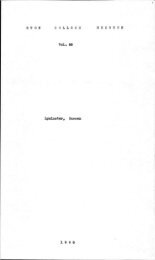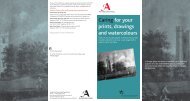http://www.learningcurve.gov.uk/victorianbritain/divided/default.htm ...
http://www.learningcurve.gov.uk/victorianbritain/divided/default.htm ...
http://www.learningcurve.gov.uk/victorianbritain/divided/default.htm ...
Create successful ePaper yourself
Turn your PDF publications into a flip-book with our unique Google optimized e-Paper software.
<strong>http</strong>://<strong>www</strong>.<strong>learningcurve</strong>.<strong>gov</strong>.<strong>uk</strong>/<strong>victorianbritain</strong>/<strong>divided</strong>/<strong>default</strong>.<strong>htm</strong><br />
Page 1 of 25
Source 1:<br />
Ragged school<br />
Most of the visitors to the Great Exhibition came on days<br />
when the tickets cost a shilling, or five pence. About<br />
4,500,000 people came on these 'shilling days'. These were<br />
working people, who came from all over Britain. The first<br />
'shilling day' was expected to lead to a great deal of trouble.<br />
One MP, Colonel Sibthorpe warned that there would be crime<br />
and disorder.<br />
So on the first 'shilling day' there was a heavy police<br />
presence. But nothing happened. In the five and a half months<br />
that the Great Exhibition was open, only seven people were<br />
arrested and there was hardly any vandalism.<br />
The men who policed the Great Exhibition were members of<br />
the Metropolitan Police force.<br />
This force had been established in 1829 and its police<br />
constables were given the nickname 'Peelers' after Sir Robert<br />
Peel who was Home Secretary at the time. Until the 1820s the<br />
main emphasis in law and order was on punishment, because<br />
there were few police forces.<br />
There were 400 offences that carried the death penalty,<br />
including picking someone’s pocket of anything worth one<br />
shilling (5p) or more and stealing anything worth £2.00. Sir<br />
Robert Peel abolished almost all of the capital offences (those<br />
that carried the death penalty) and also began to reform<br />
prisons, as well as setting up the Metropolitan Police Force.<br />
<strong>http</strong>://<strong>www</strong>.<strong>learningcurve</strong>.<strong>gov</strong>.<strong>uk</strong>/<strong>victorianbritain</strong>/<strong>divided</strong>/<strong>default</strong>.<strong>htm</strong><br />
Page 2 of 25<br />
Source 2:<br />
Report on<br />
working women
Source 3:<br />
Report on<br />
women in mines<br />
Source 5:<br />
Workhouse,<br />
1851<br />
Peel wanted to put the emphasis upon preventing crime,<br />
rather than punishing criminals. Some of the novels of Charles<br />
Dickens, who was writing in the 1830s and 1840s, show how<br />
lawless the streets of British cities could be.<br />
In ‘Oliver Twist’ Fagin runs a gang of pickpockets, and Bill<br />
Sykes is a violent and dangerous criminal. In ‘Great<br />
Expectations’, Pip is befriended by the convict Magwitch, who<br />
had escaped from a hulk.<br />
At first the Police Force was not very popular. People were<br />
very concerned that the new police should not be like the<br />
military and therefore great care was taken to ensure that<br />
police constables did not look like soldiers.<br />
This is why peelers wore top hats instead of helmets and<br />
carried truncheons instead of rifles, although cutlasses were<br />
available for emergencies!<br />
The success of the Metropolitan Police Force, however, led<br />
other parts of the country to set up their own forces. However,<br />
it did not become compulsory for counties and boroughs to<br />
have police forces until 1856. The duties of the police were<br />
extended as more and more laws were passed.<br />
For example the 1872 Licensing Act made them responsible<br />
for supervising public drinking places. Policing was not the<br />
only aspect of law and order that changed during the Victorian<br />
period.<br />
The ways in which criminals were punished were also<br />
changed. 1857 saw the end of Hulk ships. These were<br />
anchored ships, which held prisoners who were either<br />
awaiting transportation to the colonies, or were used to carry<br />
out public works, such as clearing the River Thames.<br />
<strong>http</strong>://<strong>www</strong>.<strong>learningcurve</strong>.<strong>gov</strong>.<strong>uk</strong>/<strong>victorianbritain</strong>/<strong>divided</strong>/<strong>default</strong>.<strong>htm</strong><br />
Page 3 of 25<br />
Source 4:<br />
Report on<br />
children in mines<br />
Source 6:<br />
Servants' wages,<br />
1890s
Source 7:<br />
Article on<br />
women's work<br />
Source 9:<br />
Disraeli on<br />
votes for women<br />
The transportation of criminals gradually declined and the last<br />
convict ship arrived in Australia in 1868. These changes led to<br />
a new prison building programme based upon the model<br />
prison at Pentonville. Inside these new prisons, prisoners<br />
were separated, forbidden to communicate with each other<br />
and given meaningless work to do. But did these changes<br />
make a difference?<br />
<strong>http</strong>://<strong>www</strong>.<strong>learningcurve</strong>.<strong>gov</strong>.<strong>uk</strong>/<strong>victorianbritain</strong>/<strong>divided</strong>/<strong>default</strong>.<strong>htm</strong><br />
Page 4 of 25<br />
Source 8:<br />
Men & women's<br />
wages, 1906
1a. What sort of education are the children receiving in this school?<br />
1b. List the different skills you can see that are being learnt?<br />
1c. What sort of skills do you think a ragged school for girls would teach?<br />
<strong>http</strong>://<strong>www</strong>.<strong>learningcurve</strong>.<strong>gov</strong>.<strong>uk</strong>/<strong>victorianbritain</strong>/<strong>divided</strong>/source1.<strong>htm</strong><br />
Page 5 of 25
Ragged schools for girls and boys were set up from 1844 to educate poor children.<br />
The president of the Ragged Schools union was Lord Ashley, who later became<br />
Lord Shaftesbury. This is a print showing a Ragged School for boys.<br />
(PRO ref: ZPER 34/23, p.520)<br />
<strong>http</strong>://<strong>www</strong>.<strong>learningcurve</strong>.<strong>gov</strong>.<strong>uk</strong>/<strong>victorianbritain</strong>/<strong>divided</strong>/source1.<strong>htm</strong><br />
Page 6 of 25
2a. What did Ashley say happened when a woman went to work?<br />
2b. What do you think Ashley believed about the status of men and women?<br />
<strong>http</strong>://<strong>www</strong>.<strong>learningcurve</strong>.<strong>gov</strong>.<strong>uk</strong>/<strong>victorianbritain</strong>/<strong>divided</strong>/source2.<strong>htm</strong><br />
Page 7 of 25
This is an extract from Lord Ashley’s Employment of Women and Children Report<br />
1842. He was criticising the employment of women in coalmines and describing<br />
what happened in families where the wife worked.<br />
(PRO ref: ZHC 2/79, p.1335)<br />
<strong>http</strong>://<strong>www</strong>.<strong>learningcurve</strong>.<strong>gov</strong>.<strong>uk</strong>/<strong>victorianbritain</strong>/<strong>divided</strong>/source2.<strong>htm</strong><br />
Page 8 of 25
3a In what ways does Mr. Wood's statement support Lord Ashley’s opinions? See Source 2<br />
3b Why do the mine owners prefer to employ women in the mines according to Mr. Sadler?<br />
3c In your opinion, which of these two statements presents the strongest case against<br />
women working in the mines?<br />
<strong>http</strong>://<strong>www</strong>.<strong>learningcurve</strong>.<strong>gov</strong>.<strong>uk</strong>/<strong>victorianbritain</strong>/<strong>divided</strong>/source3.<strong>htm</strong><br />
Page 9 of 25
Witness statements included in Lord Ashley’s 1842 report. The first statement is<br />
made by Mr. Wood and the second is made by Mr. Sadler.<br />
(PRO ref: ZHC 2/79, p.1338)<br />
<strong>http</strong>://<strong>www</strong>.<strong>learningcurve</strong>.<strong>gov</strong>.<strong>uk</strong>/<strong>victorianbritain</strong>/<strong>divided</strong>/source3.<strong>htm</strong><br />
Page 10 of 25
4a. What work were women doing in the coal mines?<br />
4b. What was being criticised in the report?<br />
Think about the evidence in sources 2, 3 and 4.<br />
4c. Summarise the concerns that the report raises about women and girls working in the<br />
mines.<br />
4d. Do you think that banning women from working in the mines was good or bad for their<br />
status?<br />
This extract comes from the same report on mines published by Lord Ashley in<br />
1842.<br />
<strong>http</strong>://<strong>www</strong>.<strong>learningcurve</strong>.<strong>gov</strong>.<strong>uk</strong>/<strong>victorianbritain</strong>/<strong>divided</strong>/source4.<strong>htm</strong><br />
Page 11 of 25
(PRO ref: ZHC 2/79, p.1327)<br />
<strong>http</strong>://<strong>www</strong>.<strong>learningcurve</strong>.<strong>gov</strong>.<strong>uk</strong>/<strong>victorianbritain</strong>/<strong>divided</strong>/source4.<strong>htm</strong><br />
Page 12 of 25
5a Write down a list of the different sorts of occupations that are given for the men in the<br />
workhouse.<br />
5b Write down a list of the different sorts of occupations that are given for the women in the<br />
workhouse.(hint – check the ages- ignore young persons who are listed as scholars)<br />
5c Which list is the longer?<br />
5d What is the most common form of work done by the women? What does this tell you<br />
about employment of men and women in the middle of the nineteenth century?<br />
<strong>http</strong>://<strong>www</strong>.<strong>learningcurve</strong>.<strong>gov</strong>.<strong>uk</strong>/<strong>victorianbritain</strong>/<strong>divided</strong>/source5.<strong>htm</strong><br />
Page 13 of 25
This is the 1851 census return for a workhouse. It lists all the people who were in<br />
the workhouse on the night of 30th March 1851. On the first page are the names of<br />
the Master and the Matron and the other officials who ran the workhouse, but after<br />
that are the names of all the paupers.<br />
<strong>http</strong>://<strong>www</strong>.<strong>learningcurve</strong>.<strong>gov</strong>.<strong>uk</strong>/<strong>victorianbritain</strong>/<strong>divided</strong>/source5.<strong>htm</strong><br />
Page 14 of 25
<strong>http</strong>://<strong>www</strong>.<strong>learningcurve</strong>.<strong>gov</strong>.<strong>uk</strong>/<strong>victorianbritain</strong>/<strong>divided</strong>/source5.<strong>htm</strong><br />
Page 15 of 25
<strong>http</strong>://<strong>www</strong>.<strong>learningcurve</strong>.<strong>gov</strong>.<strong>uk</strong>/<strong>victorianbritain</strong>/<strong>divided</strong>/source5.<strong>htm</strong><br />
Page 16 of 25
(PRO ref: HO 107/1599/1)<br />
<strong>http</strong>://<strong>www</strong>.<strong>learningcurve</strong>.<strong>gov</strong>.<strong>uk</strong>/<strong>victorianbritain</strong>/<strong>divided</strong>/source5.<strong>htm</strong><br />
Page 17 of 25
6a. What sort of work is included in this table?<br />
6b. How much did a 'between maid' earn a week?<br />
6c. What does the number of different job descriptions tell you about the importance of this<br />
kind of work?<br />
6d. In the 1901 census, more than 2,000,000 women were listed as working in these sort of<br />
jobs. Why do you think so many women did this work when the pay was so low?<br />
6e 50 years earlier in the 1851 census almost exactly 1,000,000 women were working as<br />
servants. Why do you think the number of female servants had risen so much by 1901?<br />
6f Do you think that this is evidence that women had more opportunities by 1901?<br />
Average wages of female domestic servants according to class of work. Figures<br />
collected by the Board of Trade in the 1890’s based on actual returns from 2,000<br />
households.<br />
<strong>http</strong>://<strong>www</strong>.<strong>learningcurve</strong>.<strong>gov</strong>.<strong>uk</strong>/<strong>victorianbritain</strong>/<strong>divided</strong>/source6.<strong>htm</strong><br />
Page 18 of 25
<strong>http</strong>://<strong>www</strong>.<strong>learningcurve</strong>.<strong>gov</strong>.<strong>uk</strong>/<strong>victorianbritain</strong>/<strong>divided</strong>/source6.<strong>htm</strong><br />
Page 19 of 25
7a How much were women paid in 1874 compared to men?<br />
7b What was the highest pay that a skilled woman worker could get?<br />
7c Why do you think Emma Paterson wrote this article?<br />
<strong>http</strong>://<strong>www</strong>.<strong>learningcurve</strong>.<strong>gov</strong>.<strong>uk</strong>/<strong>victorianbritain</strong>/<strong>divided</strong>/source7.<strong>htm</strong><br />
Page 20 of 25
This is part of an article written by Emma Paterson, the leader of the Women's<br />
Trade Union in 1874.<br />
<strong>http</strong>://<strong>www</strong>.<strong>learningcurve</strong>.<strong>gov</strong>.<strong>uk</strong>/<strong>victorianbritain</strong>/<strong>divided</strong>/source7.<strong>htm</strong><br />
Page 21 of 25
8a Look at this source and then think back to the census return - source 5. Do you think<br />
that women have more work opportunities by the beginning of the 20th century?<br />
8b Do these wage figures tell you anything about the importance of women workers in<br />
Britain by the beginning of the 20th century?<br />
8c Using your knowledge of history, what major event from 1914-18 will change the status<br />
of women workers in Britain and why?<br />
<strong>http</strong>://<strong>www</strong>.<strong>learningcurve</strong>.<strong>gov</strong>.<strong>uk</strong>/<strong>victorianbritain</strong>/<strong>divided</strong>/source8.<strong>htm</strong><br />
Page 22 of 25
This is a table showing the daily wages of men and women in 1906. It comes from a<br />
report published by the Board of Trade.<br />
<strong>http</strong>://<strong>www</strong>.<strong>learningcurve</strong>.<strong>gov</strong>.<strong>uk</strong>/<strong>victorianbritain</strong>/<strong>divided</strong>/source8.<strong>htm</strong><br />
Page 23 of 25
9a Why did Benjamin Disraeli believe that women should have the vote?<br />
9b Why do you think he made this speech?<br />
<strong>http</strong>://<strong>www</strong>.<strong>learningcurve</strong>.<strong>gov</strong>.<strong>uk</strong>/<strong>victorianbritain</strong>/<strong>divided</strong>/source9.<strong>htm</strong><br />
Page 24 of 25
This is part of speech made by Benjamin Disraeli, the leader of the Conservative<br />
Party in the House of Commons in April 1866. He was speaking during a debate on<br />
the Second Reform Bill.<br />
<strong>http</strong>://<strong>www</strong>.<strong>learningcurve</strong>.<strong>gov</strong>.<strong>uk</strong>/<strong>victorianbritain</strong>/<strong>divided</strong>/source9.<strong>htm</strong><br />
Page 25 of 25


